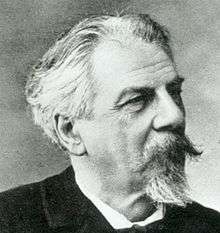Ferdinand Monoyer
Ferdinand Monoyer (9 May 1836 – 11 July 1912[1]) was a French ophthalmologist, known for introducing the dioptre in 1872.[2]

Ferdinand Monoyer | |
|---|---|
 | |
| Born | 9 May 1836 |
| Died | 11 July 1912 (aged 76) Lyon, France |
| Nationality | French |
He invented the Monoyer chart, used to test visual acuity.[3] He inserted his name in the random letters of the chart. It appears when one reads vertically from bottom to top on each side.[4]
Biography
Monoyer was of Alsatian heritage by his mother and his father was a French military doctor.[5]
He was an associate professor of medical physics at the Faculty of Medicine, University of Strasbourg in 1871.[6] Later, he was the director of the Ophthalmic Clinic of the Faculty of Medicine, Nancy-Université from 1872 to 1877. He was also professor of medical physics at the Faculty of Medicine, University of Lyon, from 1877 to 1909.[1]
Death
Monoyer died at the age of 76 years. His tomb is located in the Cimetière de la Guillotière in Lyon. On Saturday 13 July 1912, a long procession of friends and members of the Faculty of Medicine at the University of Lyon accompanied Professor Monoyer to his final resting place; Professor Hugounenq traced Monoyer's career as chair at the University of Lyon, Associate Professor Nogier spoke on behalf of the students of the late master and Louis Dor made a speech on behalf of the Ophthalmological Society of Lyon.[5]
The speech made in Monoyer's honour by the president of Société nationale de Médecine de Lyon during 11 November 1912 session of the Société was concluded as such: "To the memory of this scholar, the Medical Society bows with respect and sadness; it has lost a friend who was also her counselor who knew to think and to reflect."[5]
References
- "MONOYER (Ferdinand)". BIU Santé. Retrieved 12 September 2014.
- Keating, Michael P. (1 September 1975). "Vergence, vision, and geometric optics" (PDF). American Journal of Physics. 43 (9): 766–769. doi:10.1119/1.9703. ISSN 0002-9505.
- Koki, G.; Bella, A.-L.; Ndocko, K.-E. Mbassi; Epée, E.; Mvogo, C. Ebana; Bella, A.-L.; Ndocko, K.-E. Mbassi; Eballé, A. Omgbwa (2013). "Complications oculaires, à l'exclusion de la rétinopathie diabétique, chez le jeune diabétique de type 1, au Cameroun". Médecine des Maladies Métaboliques. 7 (5): 473–476. doi:10.1016/s1957-2557(13)70546-7. ISSN 1957-2557.
- "Le test d'acuité visuelle Monoyer cache le nom de son inventeur". secouchermoinsbete.fr (in French). Retrieved 11 September 2014.
- "LE PROFESSEUR FERDINAND MONOYER". Lyon médical: Gazette médicale et Journal de médecine réunis (in French). Société médicale des hôpitaux de Lyon. CXIX (27). July 1912. ISSN 0024-7790.
- Wundt, L. D. W. (1871). Traité élémentaire de physique médicale [Elementary Treatise of Medical Physics.] (in French). Paris: JB Bailliere et Fils.